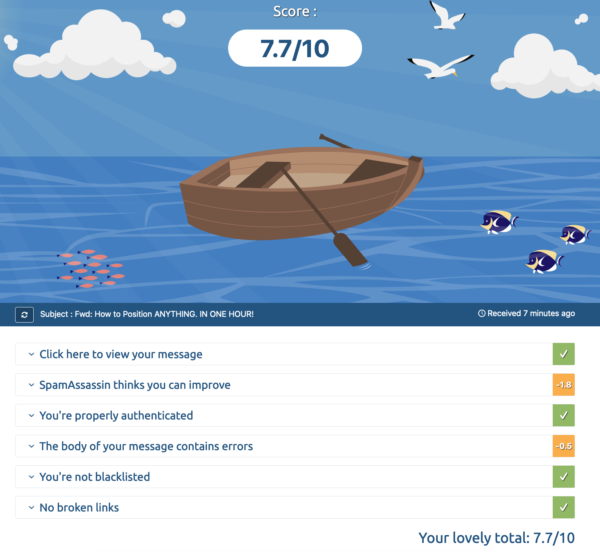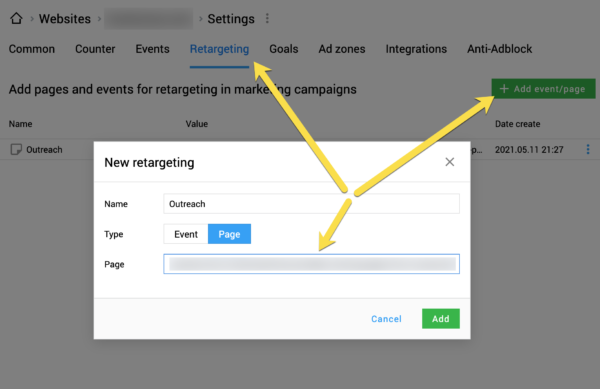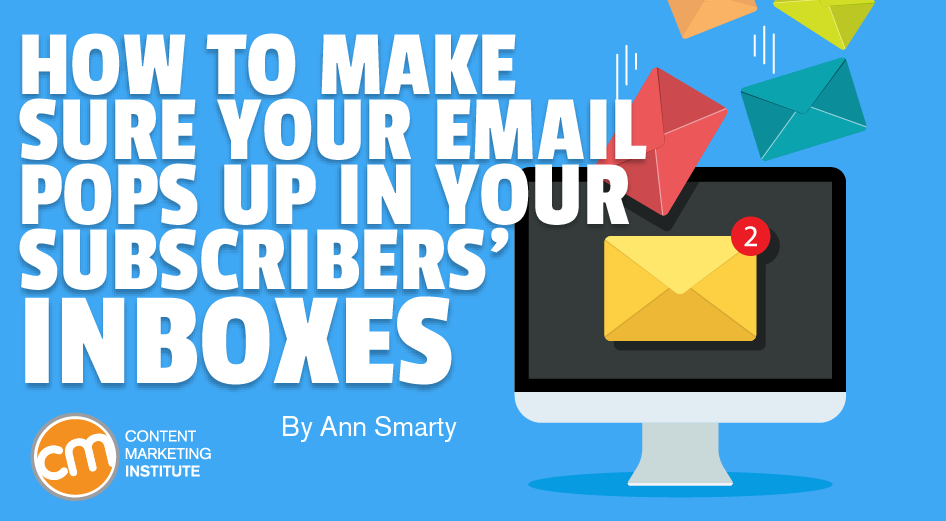 Email is still the most effective tool at any digital marketer’s disposal:
Email is still the most effective tool at any digital marketer’s disposal:
- Emails have the highest return on investment (Constant Contact).
- Almost 80% of B2B marketers say email proves to be the most successful channel for content distribution (Optin Monster).
- 60% of consumers admit to making a purchase as the result of a marketing email, while only about 12% admit to buying from social media (Optin Monster).
I could go on, but we all know what the data shows: Using emails in your marketing is almost always a good idea when done right.
Yes, you need a clickable subject line and effective copy. But before your recipients can get to all that, they need to see your email. Here’s how to make that happen.
A clickable subject line and effective copy are only good if recipients see your #email, says @SEOSmarty via @CMIContent. Click To TweetSet up a separate domain
A lot of outreach campaigns get this first (and fundamental) step wrong. Outreach campaigns are often sent from a free domain like Gmail and Yahoo or the company’s main domain name.
Free email domains look unprofessional and spammy. Plus, “free” comes at a cost: You cannot control your access to it. A complaint or suspicious activity could lead to a free domain owner deleting the account. It also can make third-party tools that follow DMARC protocols inaccessible.
Using your company’s main domain can be a risk for other reasons. If your marketing emails are marked or reported as spam, your company’s internal emails can be affected too.
This guide outlines how to set up a custom email address using your hosting provider or Google’s Workspace (formerly G Suite).
Use a custom brand domain name to send your #EmailMarketing. If not, you could risk your brand’s primary domain name email transactions, says @SEOSmarty via @CMIContent. Click To TweetWhatever address is listed as the sender, make it obvious the emails are coming from your brand.
TIP: Pick a domain that reflects your niche, which reinforces your email theme/topics.
Namify is a great tool to find a distinct email address for your marketing purposes because it suggests names that create positive brand and niche associations:

The tool checks your chosen name across multiple top-level domains:
- .press seems to be a perfect top-level domain for press outreach
- .site or .online serves general outreach purposes
- .tech works for internal communication
TIP: It is a good idea to register a few top-level domains to use for different purposes.
The main takeaway is to do this as early in your marketing as you can. You need to establish the address well before it’s integrated into your email strategy. Here’s why.
Establish the domain
Most spam blockers and anti-spam filters block emails from a new email address. For example, a popular anti-spam platform SpamAssassin marks all emails from domains younger than 14 days as “suspicious.”
Most email marketing platforms recommend using a domain at least three to four months old. To be on the safe side, keep your new email address fairly inactive for at least six months before start mass-emailing from it.
Wait to use a new custom domain for #EmailMarketing until it’s been fairly inactive for at least six months, says @SEOSmarty via @CMIContent. Click To TweetTo “warm-up” your domain prior to using it for outreach or email marketing:
- Set up a mini-site. This is beneficial for reputation management. It could be a well-branded single-page website. Someone searching for your brand name will see the main site first and that mini-site second. Even Google recommends registering multiple brand-driven domains for a stronger online presence. You can use that mini-site to explain how (and why) journalists can get in touch with your (.press) domain or to use it as your .online domain to set up your knowledge base.
- Use your newly set up address for emailing people you know (e.g., employees) for a few weeks. Ask them to reply to those emails.
- Keep one address per domain in the beginning. Slowly add more addresses when your domain is better established.
Test your email before sending
Various spam filters have all kinds of criteria when flagging or filtering emails as spam:
- Domain age and reputation (how new it is and whether it is blacklisted for suspicious activity)
- Age and reputation of domains linked in the copy
- Hidden links or HTML in the copy (URL shorteners often cause of an email being filtered)
It is hard to keep track of all the possible red flags, but some tools can do that for you. Mail Tester is my favorite checker that ensures that your email is not going to be trapped. You don’t even need to register for an account. The tool provides a unique email address to which you send your email. Your red flag report will be ready in minutes.
Use #MailTester (it’s free) to ensure your #email is not going to be trapped, says @SEOSmarty via @CMIContent. #Tools Click To TweetThe analysis will include:
- Most common spam filters (SpamAssassin and Gmail)
- Your email body (It will report if you have too many links or any suspicious elements to delete.)
- Most common blacklists
- Broken links

You also use test services available in most outreach and email marketing platforms.
Verifying your domains with Google’s Postmaster Tools is another good idea. It can track your outgoing mail and identify it was trapped by Gmail or noted as spammed by Gmail users. Though it only informs you about Gmail email recipients, chances are other email providers will have had similar challenges. It’s a good indicator of problems to fix.

Set up automatic (but smart) follow-ups
No matter how careful you are with your email address and your copy, lots of people still will fail to notice or ignore your email. Following up is so important.
In fact, following up can convert 22% more replies. Without sending a follow-up email, you would have lost one-fifth of your prospects.
Most outreach platforms offer a follow-up option that can be set up and customized in different ways. Although a few case studies show different results depending on how often and how many follow-ups you send, I suggest experimenting with different settings.
For B2B marketing, Exceed AI is a great option for AI-powered follow-ups based on the recipient’s previous interaction with your brand or where they stand in the sales cycle:

Exceed takes care of personalizing your emails based on two important criteria:
- Recipient’s basic details (i.e., name)
- Recipient’s previous purchases or communication with your brand
Personalization is one of the most effective engagement tactics out there, so make sure you personalize the emails no matter what tools and programs you use.
Retargeting tip and caveat
If you come across an email outreach guide that’s a few years old, you often find a recommendation to use your list of outreach emails as a custom audience on Facebook to retarget your message to them through the platform.
This may not be a good idea these days. Facebook has tightened its rules and only permits retargeting for opt-in email lists in which people explicitly allowed you to use their emails to target them on Facebook. Chances are you do not have that permission, so using those email addresses on Facebook may not be lawful.
However, you can remarket to some of your email contacts following this process:
- Link to a dedicated landing page from your outreach email.
- Install Facebook pixel to capture incoming traffic to that landing page.
After a few weeks, you can use Facebook Ads to reach out to your email recipients who visited that landing page.
You also can use Finteza to retarget those people who visited that page. To create an outreach-driven campaign with this tool:
- Create a retargeting event: In your site settings, click “Events,” choose “Retargeting” and specify the landing page linked in your email:

- Create a retargeting campaign: Go to account settings to set up a campaign using your retargeting event:

With the campaign created, you can set up custom creatives and calls to action to show visitors who entered your site through that page. These could be a CTA inviting your site visitors to get in touch with your press department or a link to your survey results.
While this retargeting step won’t help you reach those people who failed to see your email or click your link, it will help you build some brand recognizability and save some bounces.
Get a welcome from inboxes
Email content marketing works only if your recipients see the emails. With some extra effort, you can increase the chance your emails will be delivered and opened by your contacts.
All tools identified in this article come from the author. If you have a tool to suggest, please add it in the comments.
Cover image by Joseph Kalinowski/Content Marketing Institute

